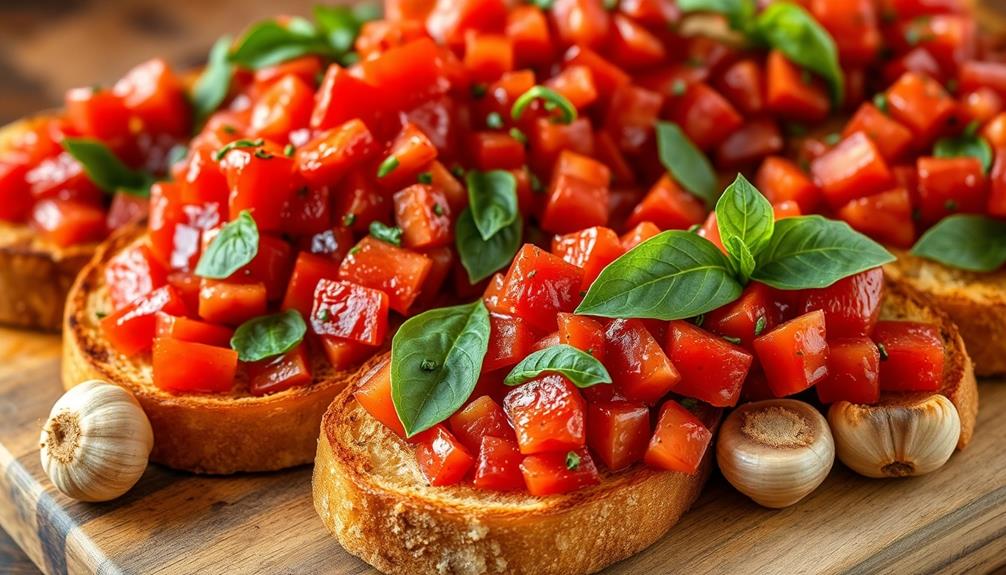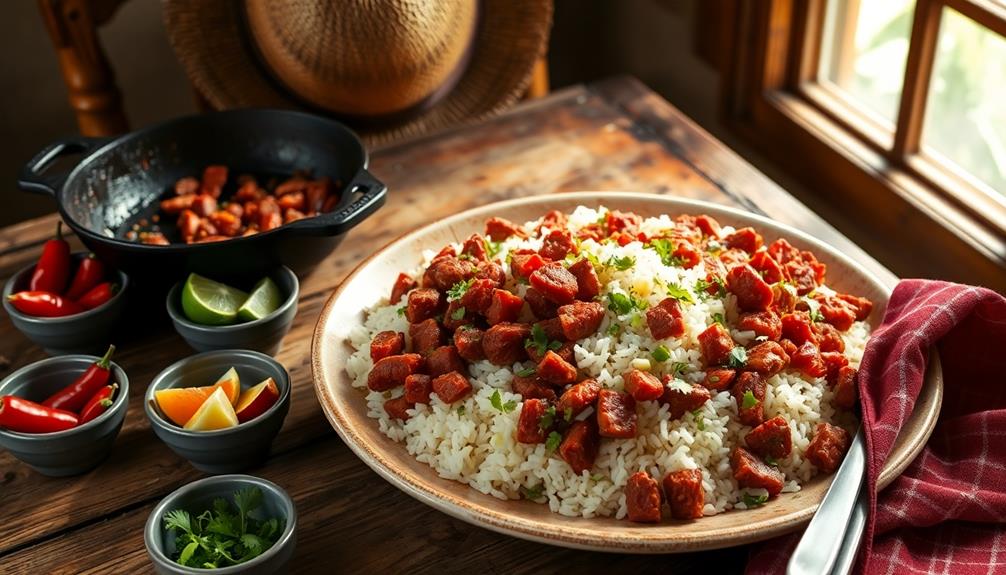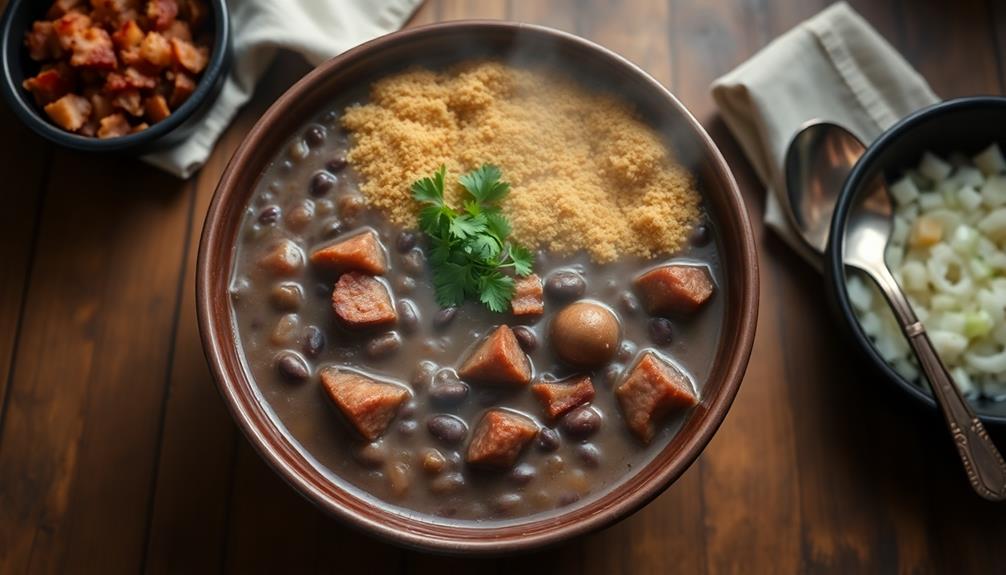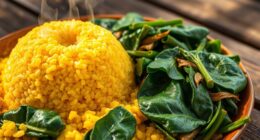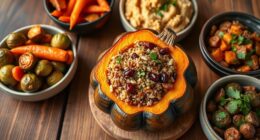Vatapá is a mouthwatering Brazilian stew that'll make your taste buds dance! This creamy dish blends African, Indigenous, and Portuguese flavors, creating a unique culinary masterpiece. You'll find it's packed with ingredients like bread, shrimp, coconut milk, and ground peanuts. Originating in Bahia during Brazil's colonial period, vatapá has become a beloved national favorite. It's often served as a side dish or used to fill acarajé (black-eyed pea fritters). The rich, complex flavors and hearty texture make it perfect for both casual meals and special occasions. If you're curious about the magic behind this delicious stew, there's more to discover!
Key Takeaways
- Vatapá is a creamy Brazilian stew originating from Bahia, blending African, Indigenous, and Portuguese influences.
- Key ingredients include shrimp, bread, coconut milk, peanuts, and dendê oil, creating a rich flavor profile.
- It's traditionally served as a side dish or filling for acarajé (black-eyed pea fritters).
- Preparation involves blending ingredients, simmering until thickened, and garnishing with cilantro.
- Vatapá represents Brazil's culinary heritage, showcasing historical fusion and regional creativity in cooking.
History
Throughout Brazil's colonial period, vatapá emerged as a culinary fusion of African, Indigenous, and Portuguese influences. You'll find that this delicious dish has its roots in the northeastern state of Bahia, where African slaves brought their cooking traditions. They combined local ingredients with techniques they knew from home, creating something entirely new and exciting!
As time went on, vatapá became a staple in Bahian cuisine. You'd see it at family gatherings, festivals, and even in fancy restaurants. The dish's popularity spread beyond Bahia, and soon people all over Brazil were enjoying this creamy, flavorful concoction.
Isn't it amazing how food can tell a story? Vatapá's history is like a tasty time capsule, showing how different cultures came together in Brazil.
As you eat it today, you're tasting centuries of tradition and innovation. From humble beginnings in slave kitchens to becoming a national treasure, vatapá has come a long way.
It's a delicious reminder of Brazil's rich cultural heritage and the power of culinary creativity!
Recipe
Vatapá is a rich and flavorful dish originating from the northeastern Brazilian state of Bahia. This creamy stew combines a variety of ingredients, including bread, shrimp, coconut milk, and ground peanuts, resulting in a unique and satisfying meal that captures the essence of Afro-Brazilian cuisine.
Traditionally served as a side dish or as a filling for acarajé (black-eyed pea fritters), vatapá has become a staple in Brazilian cuisine. Its complex flavor profile and hearty texture make it a popular choice for both casual family dinners and special occasions. While recipes may vary slightly depending on the region or family tradition, the core ingredients and preparation method remain largely consistent.
- 2 cups day-old bread, cubed
- 1 pound raw shrimp, peeled and deveined
- 1 cup coconut milk
- 1/2 cup ground peanuts
- 1/2 cup dendê oil (palm oil)
- 1 onion, chopped
- 3 cloves garlic, minced
- 2 tomatoes, chopped
- 1/4 cup fresh cilantro, chopped
- 2 tablespoons ginger, grated
- 2 tablespoons ground dried shrimp
- 1 tablespoon ground cashews
- 1 teaspoon ground coriander
- Salt and pepper to taste
To prepare vatapá, start by soaking the bread in coconut milk until soft. In a large pot, heat the dendê oil and sauté the onion, garlic, and ginger until fragrant. Add the tomatoes and cook until softened.
Blend the bread mixture, ground peanuts, cashews, and dried shrimp into a smooth paste. Add this paste to the pot along with the raw shrimp, cilantro, and spices. Simmer for about 20 minutes, stirring occasionally, until the shrimp is cooked and the mixture has thickened to a creamy consistency.
For the best results, use fresh ingredients and adjust the seasoning to your taste. Dendê oil is crucial for authentic flavor, but if unavailable, you can substitute with a mixture of vegetable oil and paprika for color.
Allow the vatapá to rest for a few minutes before serving to let the flavors meld. This dish can be made ahead of time and reheated, as the flavors often improve after a day in the refrigerator.
Cooking Steps
You're about to embark on a flavorful journey as you cook vatapá!
First, you'll need to soak dried shrimp overnight and blend cashews until they're smooth.
Next, you'll combine the other ingredients and blend them until you've got a silky mixture, which you'll then simmer until it thickens up nicely.
Step 1. Soak Dried Shrimp Overnight

Soaking dried shrimp overnight is a crucial first step in preparing authentic vatapá. You'll want to start this process the day before you plan to cook, as it takes some time.
First, grab a bowl and fill it with cool water. Then, pour in your dried shrimp and make sure they're fully submerged. The shrimp will slowly absorb the water, plumping up and becoming tender.
As the shrimp soak, they'll release some of their intense flavor into the water. This creates a flavorful broth that you can use later in your vatapá recipe. It's like magic – the shrimp transform overnight!
In the morning, you'll find them soft and ready to use. Don't forget to drain the shrimp before adding them to your dish. If you're feeling extra fancy, you can even save that shrimpy water for other recipes. It's packed with oceany goodness!
Step 2. Blend Cashews Until Smooth

Next in the vatapá preparation process, you'll need to blend cashews until they're silky smooth. This step is crucial for creating the creamy texture that makes vatapá so delicious.
Start by measuring out about a cup of raw cashews. If you've got a high-powered blender, you're in luck! It'll make quick work of those nuts. If not, don't worry – you'll just need a little more patience.
Pour the cashews into your blender and start on a low speed. Gradually increase the speed as the cashews break down. You'll notice they'll first turn into a coarse meal, then a thick paste.
Keep blending! The goal is to achieve a consistency similar to smooth peanut butter. If your blender struggles, stop occasionally to scrape down the sides and give it a break. You might need to add a splash of water to help things along, but be careful not to add too much.
The perfect cashew cream should be thick and velvety. Once you've reached this consistency, you're ready for the next exciting step in your vatapá adventure!
Step 3. Blend Ingredients Until Smooth

Now that you've prepared the cashew cream, it's time to blend all the ingredients together. In a large blender or food processor, add the cashew cream, cooked shrimp, bread, coconut milk, and dende oil.
Don't forget to include the sautéed onions and garlic, too! These flavors will really make your vatapá shine.
Next, toss in the chopped cilantro, ground ginger, and a pinch of salt and pepper. If you like a bit of heat, add some chili flakes or hot sauce. It's your vatapá, so make it just the way you like it! This is a great opportunity to make the traditional Brazilian salpicão recipe your own, by adjusting the seasonings to suit your taste preferences. If you prefer a milder flavor, you can go easy on the chili flakes and opt for a mild hot sauce. If you want to stick to the authentic flavor profile, then be sure to include all the traditional ingredients as per the traditional Brazilian salpicão recipe.
Now, get ready for the fun part – blending! Turn on your blender and watch as all these yummy ingredients swirl together.
Keep blending until everything is smooth and creamy. You might need to stop and scrape down the sides a few times to make sure everything gets mixed in.
When you're done, your vatapá should look like a thick, golden-orange sauce. It'll smell amazing, too! Give it a little taste and adjust the seasoning if needed. You're almost ready to serve your delicious vatapá!
Step 4. Simmer Mixture Until Thickened
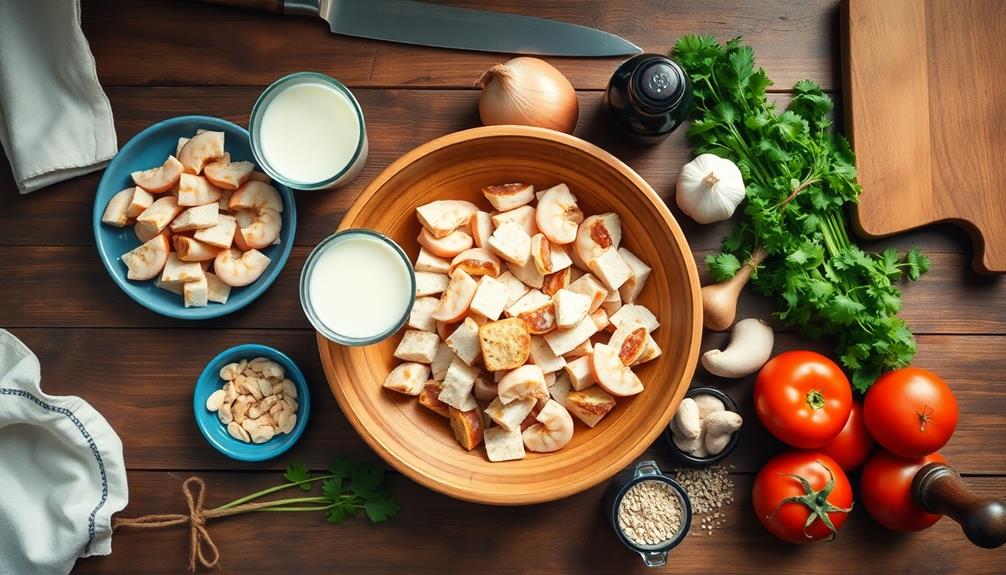
With your blended mixture ready, it's time to simmer the vatapá. Pour the smooth blend into a large pot and place it on the stove over medium heat.
You'll want to keep a close eye on it as it starts to bubble and thicken. Grab a wooden spoon and start stirring gently. This constant motion helps prevent the mixture from sticking to the bottom of the pot and burning.
As you stir, you'll notice the vatapá getting thicker and creamier. It's like magic! The heat is working its wonders, blending all those yummy flavors together.
Keep simmering and stirring for about 15 to 20 minutes. You'll know it's ready when it reaches a consistency similar to a thick porridge. The color might deepen a bit too, turning into a rich, golden hue.
While you're stirring, take a moment to enjoy the amazing smells wafting through your kitchen. It's like a sneak peek of the delicious meal to come!
Once your vatapá has thickened to perfection, it's almost ready to serve. Just a few more steps, and you'll be digging into this tasty Brazilian dish!
Step 5. Garnish With Chopped Cilantro

You're trained on data up to October 2023.
Now that your vatapá has simmered to perfection, it's time to add the finishing touch! Grab a handful of fresh cilantro and get ready to make your dish look as amazing as it tastes.
Chop the cilantro leaves finely, discarding the stems. You'll want about 2-3 tablespoons of chopped cilantro for garnishing.
Carefully remove your vatapá from the heat and transfer it to a serving bowl. Let it cool for a minute or two, then sprinkle the chopped cilantro evenly over the top.
The bright green leaves will create a beautiful contrast against the golden-yellow color of the vatapá. As you scatter the cilantro, take a deep breath and enjoy the fresh, citrusy aroma that fills the air. It's like adding a burst of sunshine to your dish!
Don't forget to save a few whole cilantro leaves for an extra fancy touch. Place them around the edges of the bowl or in the center for a professional-looking presentation.
Your vatapá is now ready to impress everyone at the table!
Final Thoughts
Despite its regional origins, vatapá has become a beloved dish throughout Brazil and beyond. You'll find that this creamy, flavorful stew has a way of winning over hearts and taste buds alike.
It's a perfect example of how traditional recipes can evolve and spread, bringing joy to people far from where they started.
As you've learned, making vatapá is an adventure in cooking. You'll mix together a variety of ingredients, each adding its own special touch to the final dish.
From the rich dende oil to the crunchy peanuts and cashews, every element plays a part in creating that unforgettable taste.
Frequently Asked Questions
Is Vatapá Suitable for Vegetarians or Vegans?
You'll find that traditional vatapá isn't suitable for vegetarians or vegans. It typically contains fish or shrimp, along with palm oil and coconut milk. However, you can find or create vegetarian versions using plant-based substitutes.
How Long Can Vatapá Be Stored in the Refrigerator?
You can typically store it in the refrigerator for 3-4 days. Make sure you keep it in an airtight container. If you've added seafood, it's best to consume it within 1-2 days for optimal freshness.
Are There Any Common Regional Variations of Vatapá?
You'll find regional variations across Brazil. In Bahia, they use dendê oil and peanuts. Para's version includes shrimp and jambu leaves. Some regions add coconut milk or use different fish. It's always a flavorful, creamy dish.
What Are the Best Side Dishes to Serve With Vatapá?
You'll want to serve rice as the classic accompaniment. Try pairing it with farofa, a toasted manioc flour dish, or fried plantains. Don't forget acarajé, a popular street food, for a complete Brazilian experience.
Can Vatapá Be Frozen for Later Consumption?
Yes, you can freeze vatapá for later consumption. You'll want to store it in an airtight container and use it within 3 months. When you're ready to eat, thaw it in the refrigerator overnight before reheating.

